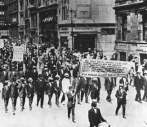|
|
 |
 |
|
Reading Guide |
| 4. |
Protest
| - | NAACP, "Fighting a Vicious Film," pamphlet, 1915, excerpts |
| - | D. W. Griffith, Birth of a Nation, film, 1915, videoclips |
| - | NAACP, flyer for the Silent Protest parade, 1917 |
| - | Monroe Trotter, On his meeting with President Wilson, The Crisis, January 1915 |
|
|
 Silent Protest parade, 1917 |
The NAACP faced a heavy agenda. Discrimination, violence, and incendiary anti-black media were escalating. making life even more precarious for African Americans. Their hope in the new president Woodrow Wilson was quashed when, one month after his inauguration in 1913, he ordered the segregation of all federal workplaces. In quick response, the NAACP launched a protest campaign through its increasing number of local chapters, a tactic it would use two years later against the incendiary film Birth of a Nation. It also began its long history of appealing to the courts to enforce the civil rights guaranteed in the Constitution. In cases initiated by the NAACP, the Supreme Court struck down the use of the grandfather clause in 1915, and in 1917 overturned laws requiring segregated neighborhoods. 1917 also saw the NAACP's first protest parade, organized after the horrific massacre of blacks in East St. Louis, Illinois, considered one of the worst "race riots" in U.S. history. These documents testify to the innovative spirit of the NAACP in creating protest methods that proved effective through the Civil Rights Movement of the 1950s/60 and beyond. 7 pages.
Discussion questions
- What modes of media influence did the NAACP learn to use?
- What forms of power did it accrete?
- What levels of cooperation among blacks and whites did the NAACP achieve?
- What were the most significant obstacles to achieving its goals?
- From these readings, what attests to the NAACP's survival?
|
» Link |
 |
 |
Topic Framing Questions
| • |
What gains and setbacks mark the period of 1907 to 1917 for black Americans? |
| • |
To what extent did African Americans set their own paths forward? |
| • |
How were the lives of ordinary black people affected by black and white leadership? |
| • |
What identity had African Americans created, as a group, between 1865 and 1917? |
| • |
What insights could black Americans take forward into the postwar years and the 1920s?
|
|
|
 |
 |
|
 |
